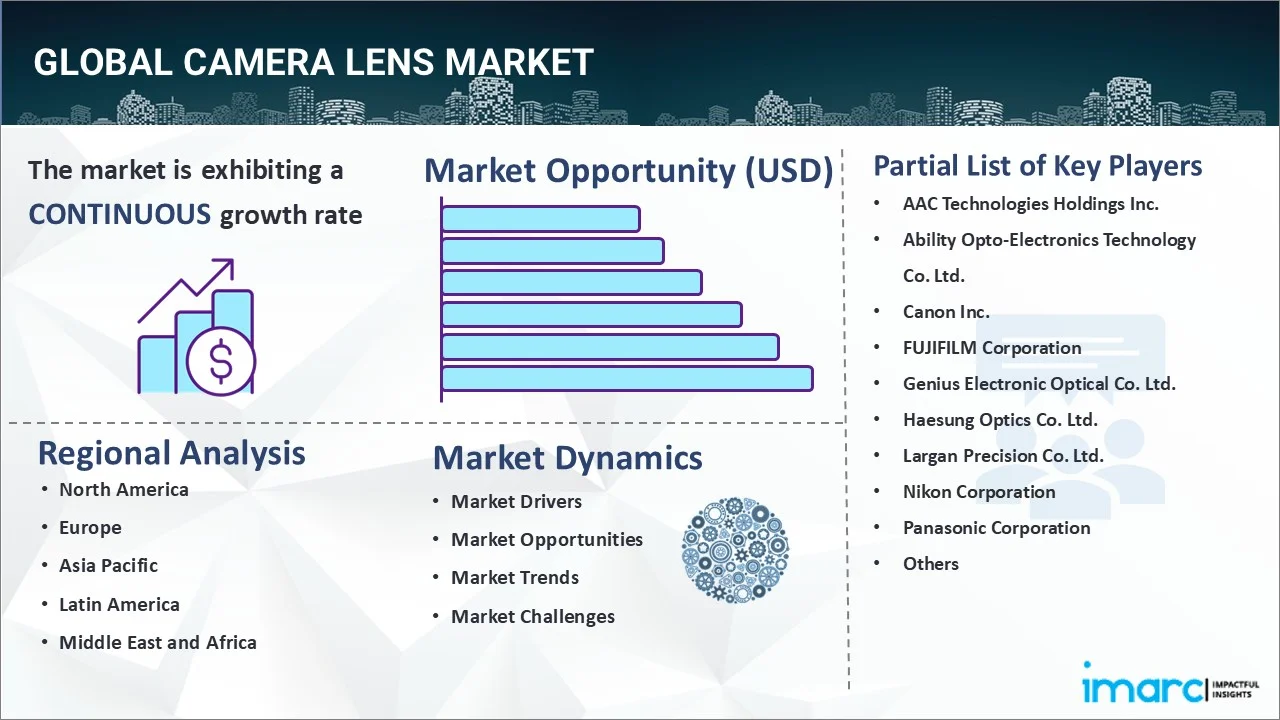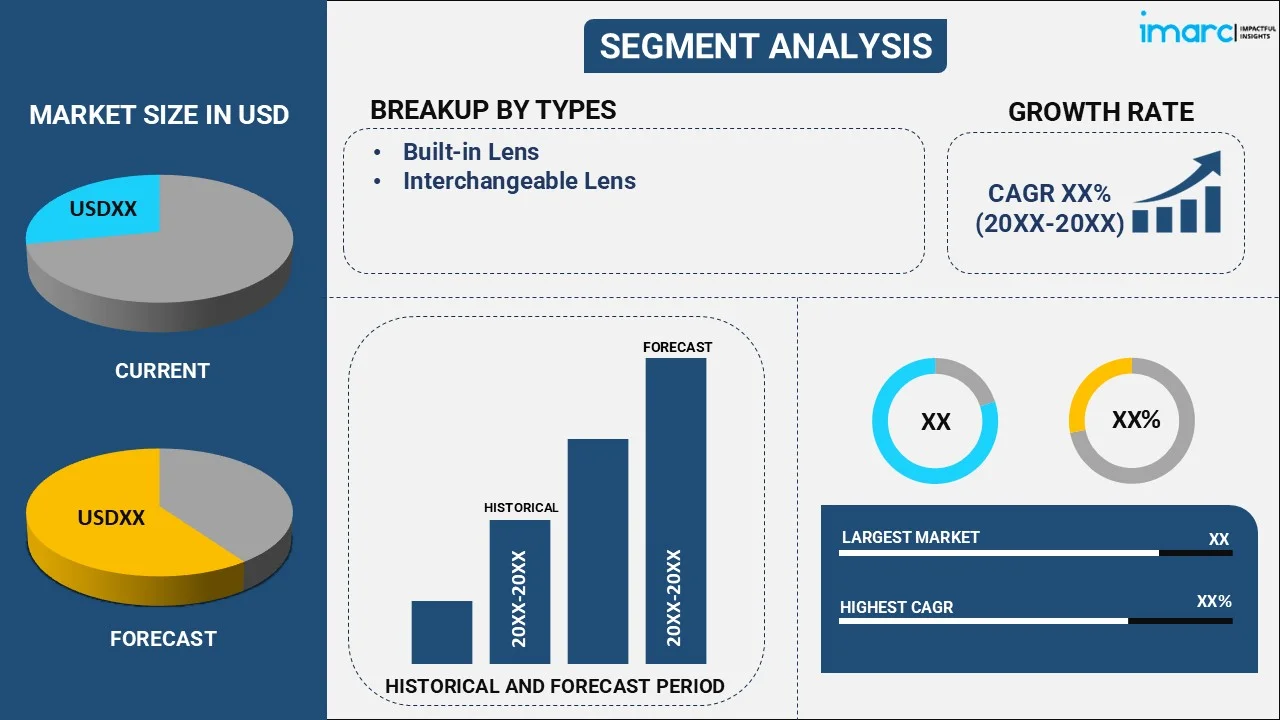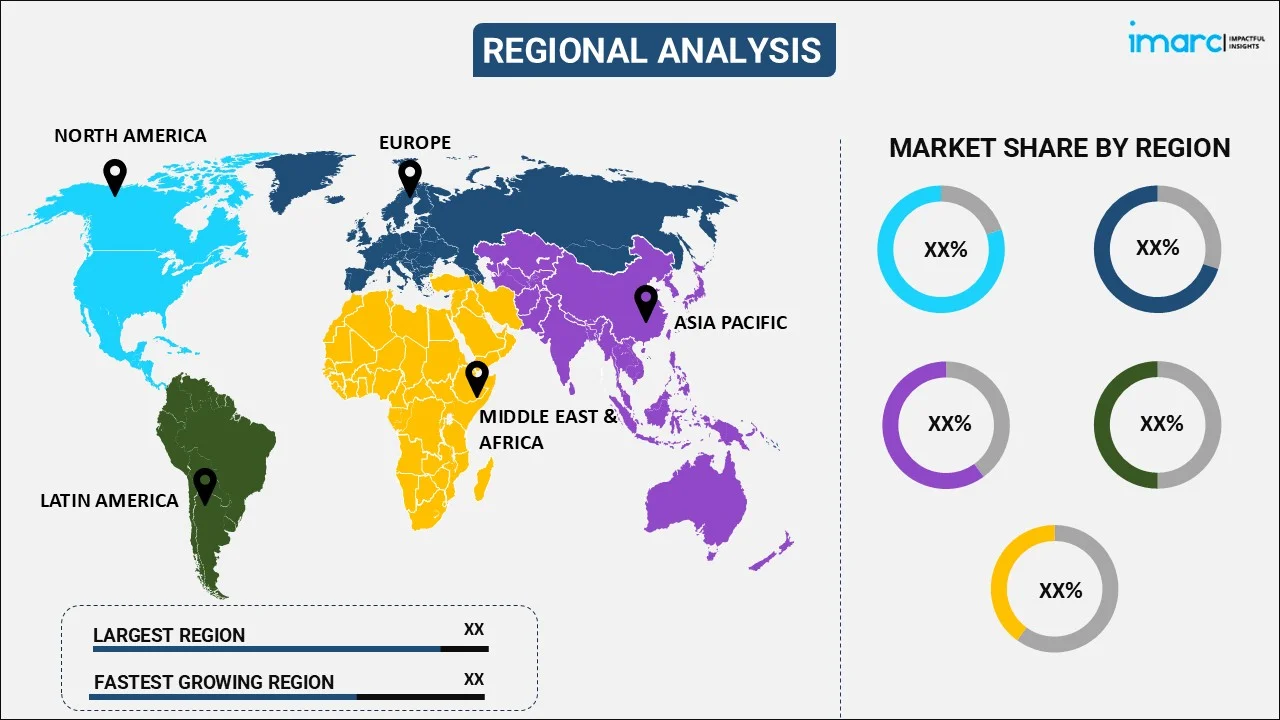
Camera Lens Market Report by Type (Built-in Lens, Interchangeable Lens), Distribution Channel (Online, Offline), Application (Consumer Electronics, Automotive, Medical, and Others), and Region 2025-2033
Market Overview:
The global camera lens market size reached USD 5.6 Billion in 2024. Looking forward, IMARC Group expects the market to reach USD 8.7 Billion by 2033, exhibiting a growth rate (CAGR) of 4.82% during 2025-2033. The rising popularity of photography among individuals, various advancements in digital camera technology, the increasing adoption of smartphones with advanced camera systems, and expanding professional photography and videography industries are some of the major factors propelling the market.
|
Report Attribute
|
Key Statistics
|
|---|---|
|
Base Year
|
2024 |
|
Forecast Years
|
2025-2033 |
|
Historical Years
|
2019-2024
|
|
Market Size in 2024
|
USD 5.6 Billion |
|
Market Forecast in 2033
|
USD 8.7 Billion |
| Market Growth Rate 2025-2033 | 4.82% |
A camera lens is a specialized optical component designed to capture and focus light onto a camera's image sensor or film plane. It is a critical part of a camera system that plays a significant role in determining the quality, composition, and characteristics of the photographs or videos captured. These lenses comprise multiple glass or plastic elements arranged in a specific configuration. They work together to control the way light enters the camera, refracting and focusing it onto the camera's sensor or film. In addition, they are available in various types and designs to suit different photography needs and genres.

The increasing utilization of high-performance camera lenses in the automobile industry for rearview optics, backup camera systems, heads-up displays (HUDs), and location-sensing devices. In addition, the escalating demand for specialized lenses catering to niche photography genres such as wildlife, astrophotography, macro, and sports represents another major growth-inducing factor. These lenses offer unique features, such as long focal lengths, wide apertures, and image stabilization, enabling photographers to capture subjects that require specific techniques and equipment. Besides this, as disposable income rises in many regions, consumers are more willing to invest in high-quality camera equipment, including lenses. Moreover, the growth of online retail and e-commerce platforms has made it easier for consumers to access a wide variety of camera lenses. These platforms offer extensive product information, customer reviews, and competitive pricing, enabling consumers to make informed purchase decisions conveniently, which is positively influencing the market growth.
Camera Lens Market Trends/Drivers:
The rising popularity of photography among individuals
As more individuals develop an interest in photography, there is a corresponding increase in the demand for camera lenses. People who engage in photography as a hobby or passion often seek to expand their creative capabilities and achieve better image quality. This drives them to invest in additional lenses beyond the standard kit lens that comes with their camera, leading to increased sales in the camera lens market. Moreover, social media platforms have played a significant role in popularizing photography and driving interest in visual storytelling. Platforms like Instagram, Facebook, and Flickr have created communities where photographers can showcase their work, exchange ideas, and inspire others. The desire to create visually appealing content for social media platforms has led individuals to invest in higher-quality camera equipment, including lenses, to improve the aesthetics of their photographs and stand out in the competitive online space.
The expanding professional photography and videography industries
Professional photographers and videographers require high-quality lenses that can deliver superior image quality, precise focusing, and exceptional performance in various shooting conditions. As the professional photography and videography industries expand, there is a growing demand for lenses that meet the rigorous standards of these professionals. Moreover, the professional photography and videography industries encompass a wide range of specialized applications, such as wedding photography, fashion photography, sports photography, wildlife photography, documentary filmmaking, and more. As a result, each of these fields requires specific lenses designed to meet the unique demands and challenges of the genre, which is also contributing to market growth.
The increasing adoption of smartphones with advanced camera systems
Smartphones have become the primary cameras for many individuals due to their convenience, portability, and continuous improvements in camera technology. This has led to a surge in demand for smartphone camera lenses that can enhance the capabilities of smartphone cameras and offer additional creative options. Besides, users often turn to accessory lenses to enhance the versatility and capabilities of smartphone cameras. These attachable lenses, also known as clip-on or lens attachments, can be easily mounted over the smartphone camera lens, expanding the range of focal lengths, providing wide-angle or telephoto options, or enabling macro photography. Moreover, smartphone manufacturers are continuously improving the camera capabilities of their devices, introducing advanced features like multiple lenses, larger sensors, optical image stabilization, and computational photography. These factors collectively influence the demand for camera lenses.
Camera Lens Industry Segmentation:
IMARC Group provides an analysis of the key trends in each segment of the global camera lens market report, along with forecasts at the global, regional, and country levels from 2025-2033. Our report has categorized the market based on type, distribution channel, and application.
Breakup by Type:

- Built-in Lens
- Interchangeable Lens
- Prime Lens
- Wide Angle Lens
- Mid-Range Lens
- Telephoto Lens
- Others
The report has provided a detailed breakup and analysis of the camera lens market based on the type. This includes built-in lens and interchangeable lens (prime, wide angle, mid-range, telephoto, and other lenses).
Smartphones have revolutionized the camera industry, and their built-in lenses have become immensely popular. As smartphones continue to improve their camera capabilities, including the integration of multiple lenses, larger sensors, and advanced computational photography features, they have become the primary cameras for many users. This has led to a substantial market share for built-in lenses, driven by the widespread adoption of smartphones. Moreover, some camera systems, such as advanced compact cameras and bridge cameras, feature non-interchangeable lenses that are integrated into the camera body, which is increasing the adoption of built in lenses.
DSLRs and mirrorless cameras are popular among photography enthusiasts, professionals, and those who prioritize the ability to change lenses. These camera systems offer a wide range of lens options and provide greater control over image quality, depth of field, and creative possibilities. The interchangeable lens market is dominant within these camera systems, accounting for a significant share due to the inherent flexibility and versatility they offer.
Breakup by Distribution Channel:
- Online
- Offline
Offline holds the largest share in the camera lens market
A detailed breakup and analysis of the camera lens market based on the distribution channel has also been provided in the report. This includes online and offline. According to the report, offline accounted for the largest market share.
Camera lenses are considered a significant investment for many photographers and videographers. Offline retail allows customers to have a hands-on experience with the lenses, physically trying them on cameras, and assessing the build quality, ergonomics, and features. Customers often prefer to compare different lenses side by side and seek guidance from knowledgeable sales staff, which can be valuable in making informed purchase decisions. Camera lenses often require additional accessories such as lens filters, lens hoods, lens caps, and other attachments to enhance their functionality and protect the investment. Offline retailers generally offer a wider range of accessories and add-ons, providing customers with a convenient one-stop shopping experience.
Online shopping offers convenience, allowing customers to browse, compare, and purchase camera lenses from the comfort of their homes. These platforms provide easy access to a wide range of camera lenses, including those from various manufacturers and third-party sellers, owing to which consumers are widely preferring online channel to make their purchase.
Breakup by Application:
- Consumer Electronics
- Mobile
- AR/VR/MR
- Others
- Automotive
- Medical
- Others
Consumer electronics represent the leading application segment
A detailed breakup and analysis of the camera lens market based on the application has also been provided in the report. This includes consumer electronics (mobile, AR/VR/MR, and others), automotive, medical, and others. According to the report, offline accounted for the largest market share.
Consumer electronics, such as smartphones, digital cameras, and action cameras, have been driving the demand for camera lenses. With the increasing popularity of social media and the rise of smartphone photography, there has been a growing demand for high-quality camera lenses in these devices. Moreover, smartphone manufacturers have been investing in improving camera capabilities, including lenses, to meet consumer expectations for better image quality. Additionally, digital cameras and action cameras have also contributed to the demand for camera lenses in this segment. These devices are widely used by photography enthusiasts, travelers, and sports enthusiasts who require high-performance lenses for capturing professional-quality photos and videos.
However, high-performance camera lenses are also widely used in the automobile industry for rearview optics, backup camera systems, heads-up displays (HUDs), and location-sensing devices.
Breakup by Region:

- North America
- United States
- Canada
- Asia-Pacific
- China
- Japan
- India
- South Korea
- Australia
- Indonesia
- Others
- Europe
- Germany
- France
- United Kingdom
- Italy
- Spain
- Russia
- Others
- Latin America
- Brazil
- Mexico
- Others
- Middle East and Africa
Asia Pacific exhibits a clear dominance, accounting for the largest camera lens market share
The report has also provided a comprehensive analysis of all the major regional markets, which include North America (the United States and Canada); Europe (Germany, France, the United Kingdom, Italy, Spain, Russia, and others); Asia Pacific (China, Japan, India, South Korea, Australia, Indonesia, and others); Latin America (Brazil, Mexico, and others); and the Middle East and Africa. According to the report, Asia Pacific was the largest market for camera lens.
Asia Pacific, particularly countries like China, Japan, South Korea, and Taiwan, has established itself as a major manufacturing hub for consumer electronics, including cameras and camera lenses. These countries have a strong presence of camera and lens manufacturers, which contributes to the region's market dominance. Moreover, the rapid urbanization in countries like China and India, coupled with the expanding middle class, has led to increased consumer spending on electronics and gadgets. As people in the region embrace photography as a hobby and pursue high-quality imaging products, the demand for camera lenses has surged.
Besides, the region is home to several leading camera and lens manufacturers that continuously invest in research and development (R&D) activities to introduce new and innovative products. This technological leadership, coupled with efficient production capabilities, has contributed to the region's dominance in the camera lens market.
Competitive Landscape:
The camera lens market has a dynamic competitive landscape with several key players competing for market share. Presently, various key market players are introducing mirrorless cameras with advanced features to achieve higher product differentiation. They are also developing lenses with a wide aperture for product or portrait photography. Besides this, the leading players are launching video-oriented lenses specifically tailored for video shooting, with features like smooth aperture control, silent autofocus, and minimized focus breathing. They are also collaborating with other companies to develop advanced high-quality lenses. Moreover, these players are engaging in mergers and acquisitions (M&As) and strategic alliances with various camera manufacturers to expand their market presence and offer lenses compatible with different camera systems.
The report has provided a comprehensive analysis of the competitive landscape in the global camera lens market. Detailed profiles of all major companies have also been provided. Some of the key players in the market include:
- AAC Technologies Holdings Inc.
- Ability Opto-Electronics Technology Co. Ltd.
- Canon Inc.
- FUJIFILM Corporation
- Genius Electronic Optical Co. Ltd.
- Haesung Optics Co. Ltd.
- Largan Precision Co. Ltd.
- Nikon Corporation
- Panasonic Corporation
- Samsung Electronics Co. Ltd.
- SEKONIX Co. Ltd.
- Sony Corporation
- TAMRON Co. Ltd.
Recent Developments:
- Canon Inc. launched the RF mount system, designed for its full-frame mirrorless cameras. This new mount system allowed Canon to introduce a range of high-performance lenses specifically designed for its mirrorless cameras, offering improved optical performance and advanced features.
- TAMRON Co. Ltd released compact telephoto lenses with advanced features, such as image stabilization and fast autofocus. These lenses aimed to provide photographers with a lightweight and portable solution without compromising on optical performance.
- Fujifilm Corporation continued to expand its lens lineup for its X-series mirrorless cameras. They introduced lenses with varying focal lengths and aperture ranges to meet the demands of different photography genres.
Camera Lens Market Report Scope:
| Report Features | Details |
|---|---|
| Base Year of the Analysis | 2024 |
| Historical Period | 2019-2024 |
| Forecast Period | 2025-2033 |
| Units | Billion USD |
| Scope of the Report | Exploration of Historical and Forecast Trends, Industry Catalysts and Challenges, Segment-Wise Historical and Predictive Market Assessment:
|
| Types Covered |
|
| Distribution Channels Covered | Online, offline |
| Applications Covered |
|
| Regions Covered | Asia Pacific, Europe, North America, Latin America, Middle East and Africa |
| Countries Covered | United States, Canada, Germany, France, United Kingdom, Italy, Spain, Russia, China, Japan, India, South Korea, Australia, Indonesia, Brazil, Mexico |
| Companies Covered | AAC Technologies Holdings Inc., Ability Opto-Electronics Technology Co. Ltd., Canon Inc., FUJIFILM Corporation, Genius Electronic Optical Co. Ltd., Haesung Optics Co. Ltd., Largan Precision Co. Ltd., Nikon Corporation, Panasonic Corporation, Samsung Electronics Co. Ltd., SEKONIX Co. Ltd., Sony Corporation, TAMRON Co. Ltd. etc. |
| Customization Scope | 10% Free Customization |
| Post-Sale Analyst Support | 10-12 Weeks |
| Delivery Format | PDF and Excel through Email (We can also provide the editable version of the report in PPT/Word format on special request) |
Key Benefits for Stakeholders:
- IMARC’s report offers a comprehensive quantitative analysis of various market segments, historical and current market trends, market forecasts, and dynamics of the camera lens market from 2019-2033.
- The research study provides the latest information on the market drivers, challenges, and opportunities in the global camera lens market.
- The study maps the leading, as well as the fastest-growing, regional markets. It further enables stakeholders to identify the key country-level markets within each region.
- Porter's five forces analysis assist stakeholders in assessing the impact of new entrants, competitive rivalry, supplier power, buyer power, and the threat of substitution. It helps stakeholders to analyze the level of competition within the camera lens industry and its attractiveness.
- Competitive landscape allows stakeholders to understand their competitive environment and provides an insight into the current positions of key players in the market.
Key Questions Answered in This Report
The global camera lens market was valued at USD 5.6 Billion in 2024.
We expect the global camera lens market to exhibit a CAGR of 4.82% during 2025-2033.
The widespread applications of camera lenses across the consumer electronics, automotive, and healthcare sectors for capturing sharp photos are primarily driving the global camera lens market.
The sudden outbreak of the COVID-19 pandemic had led to the implementation of stringent lockdown regulations across several nations, resulting in the temporary closure of numerous manufacturing units for camera lenses.
Based on the distribution channel, the global camera lens market has been segmented into online and offline. Currently, offline channel holds the majority of the total market share.
Based on the application, the global camera lens market can be divided into consumer electronics, automotive, medical, and others. Among these, the consumer electronics sector currently exhibits a clear dominance in the market.
On a regional level, the market has been classified into North America, Asia-Pacific, Europe, Latin America, and Middle East and Africa, where Asia-Pacific currently dominates the global market.
Some of the major players in the global camera lens market include AAC Technologies Holdings Inc., Ability Opto-Electronics Technology Co. Ltd., Canon Inc., FUJIFILM Corporation, Genius Electronic Optical Co. Ltd., Haesung Optics Co. Ltd., Largan Precision Co. Ltd., Nikon Corporation, Panasonic Corporation, Samsung Electronics Co. Ltd., SEKONIX Co. Ltd., Sony Corporation, and TAMRON Co. Ltd.
Need more help?
- Speak to our experienced analysts for insights on the current market scenarios.
- Include additional segments and countries to customize the report as per your requirement.
- Gain an unparalleled competitive advantage in your domain by understanding how to utilize the report and positively impacting your operations and revenue.
- For further assistance, please connect with our analysts.
 Request Customization
Request Customization
 Speak to an Analyst
Speak to an Analyst
 Request Brochure
Request Brochure
 Inquire Before Buying
Inquire Before Buying




.webp)




.webp)












